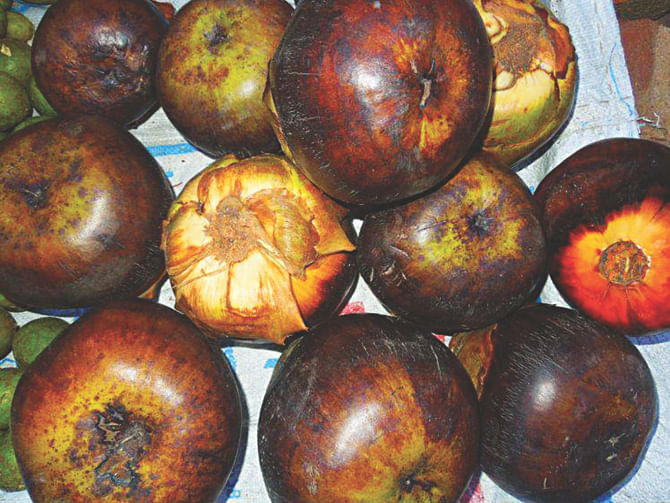Tal brings days of tasty cakes
Tal brings days of tasty cakes

The sweet smell of ripe Palmyra fruit, locally called tal, fills the air in rural areas during the ongoing Bangla month of Bhadra (mid-August to mid-September), the peak time for ripening of the popular fruit.
Bunch of ripe fruits assuming blackish red colour adorn the top of tall Palmyra trees, creating an eye catching scene against the backdrop of clouds floating in autumn sky.
In line with our age-old rural culture and tradition, villagers prepare several kinds of tasty cakes and payes, mixing Palmyra fruit juice with rice powder, honey, milk and other ingredients.
Palmyra fruit is financially profitable as a mature tree can bear around 1000 fruits annually, and a piece sells for Tk 30-Tk 40 on an average.
Its soft and tasty seeds at tender stage and sweet scented juice at mature stage are delicious as well as nutritious.
The stem of the tree can be made into boats with very little labour while the leaves are used for making hand fans, baskets, mats, puppets etc.
Golam Mostofa, former principal of Nilphamari Government Girls' College, also a teacher Bengali literature, said the Palmyra trees and fruits are part of our culture.
"Poets and writers compose poems and stories on Palmyra fruit while sweet childhood memories of picking up ripe fruits in stormy days often make us nostalgic," he added.
"Both the tender seeds and juice of ripe Palmyra fruit have high food value. Tal michhri, a kind of candy made of palm juice, is traditionally used in rural areas for herbal treatment of fever and intestine problems since ancient period," said Sneha Kanti Chakma, civil surgeon of Nilphamari.
Keramot Ali, Sadar upazila agriculture officer, suggested planting at least one Palmyra tree on every house yard as the tree yields huge quantity of fruits for long years and requires only a little care and small amount of fertiliser.
There should be research for quality development of the nutritious fruit and spread of its cultivation, he said.